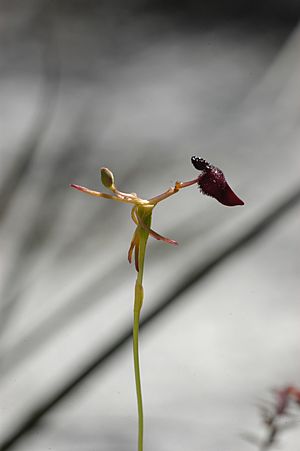King in his carriage facts for kids
Quick facts for kids King in his carriage |
|
|---|---|
 |
|
| King in his carriage on Mt Lindesay, near Denmark | |
| Scientific classification | |
| Genus: |
Drakaea
|
| Species: |
glyptodon
|
The Drakaea glyptodon, also known as the king in his carriage orchid, is a special type of orchid. It only grows in the southwest part of Western Australia. This orchid is famous for how it gets pollinated. It tricks male thynnid wasps into helping it! The orchid's special petal, called a labellum, looks and even smells like a female wasp that can't fly. This clever trick helps the orchid spread its pollen. This orchid is the most common type of Drakaea and can be found in many places.
What it Looks Like
The king in his carriage orchid, Drakaea glyptodon, has a unique look. Like other hammer orchids, it has one leaf that lies flat on the ground. It also has an underground storage part called a tuber. The leaf is shaped like a heart and is about 10 mm (0.4 inches) wide. It's smooth and a dull blue-grey color. You might see darker lines spreading out from where the leaf connects to the stem.
The stem of the orchid grows to be about 10 to 35 cm (4 to 14 inches) tall. Each stem holds a single flower. The stalk that holds the flower is about 8 to 15 mm (0.3 to 0.6 inches) long.
The flower itself looks like a female wasp that cannot fly. This is a special trick to attract male wasps. The main difference from other Drakaea orchids is that its labellum (the "wasp body") is shorter and more swollen. The flower does not have a spine on its column. This helps tell it apart from other similar orchids. For example, Drakaea elastica and Drakaea concolor also lack a spine. But D. concolor has a shiny, dark green leaf, and D. elastica has a shiny, light green leaf.
The sepal at the back of the flower is about 8 to 10 mm (0.3 to 0.4 inches) long. The two sepals on the sides are about 7 to 9 mm (0.3 to 0.4 inches) long. The petals are also about 7 to 9 mm (0.3 to 0.4 inches) long. The part of the labellum that looks like the wasp's "head" is about one-third the length of the "body." It has only a few hairs and is covered with dark bumps. The rest of the labellum, which looks like the female wasp's "body," is dark maroon. It's hairy on the top two-thirds and smooth on the bottom part. You can see these flowers from late August to late October.
How it Reproduces
The king in his carriage orchid uses a very clever trick to reproduce. It is pollinated by a specific type of male wasp called Zaspilothynnus trilobatus. The orchid's labellum looks and smells just like a female wasp. Male wasps are attracted to this fake female. When a male wasp tries to mate with the orchid's labellum, it accidentally picks up pollen. Then, when the wasp flies to another king in his carriage orchid, it drops the pollen off. This helps the orchid make seeds. This amazing trick is called "sexual deception."
Naming the Orchid
The Drakaea glyptodon was first officially described in 1882. This was done by a person named Robert D. FitzGerald. He wrote about it in a publication called The Gardeners' Chronicle.
The second part of its name, glyptodon, comes from an interesting place. It refers to an "extinct South American animal related to the Armadillo." FitzGerald thought the orchid's labellum looked like this ancient creature. He said, "The whole lip [labellum] resembles in form (miniature, of course) the enormous extinct tortoise-monster, glyptodon, a creature as large as an ox and covered with tesselated scales."
Where it Lives
The king in his carriage orchid grows in a wide area of Western Australia. You can find it from the Eneabba area all the way to Condingup, which is east of Esperance. It likes to grow in sandy or gravelly soils. You often find it near swamps that fill up with water during the winter months.
How it is Protected
The Western Australian Government Department of Parks and Wildlife has looked at the king in his carriage orchid. They have classified it as "not threatened." This means that there are enough of these orchids in the wild, and they are not currently in danger of disappearing.

